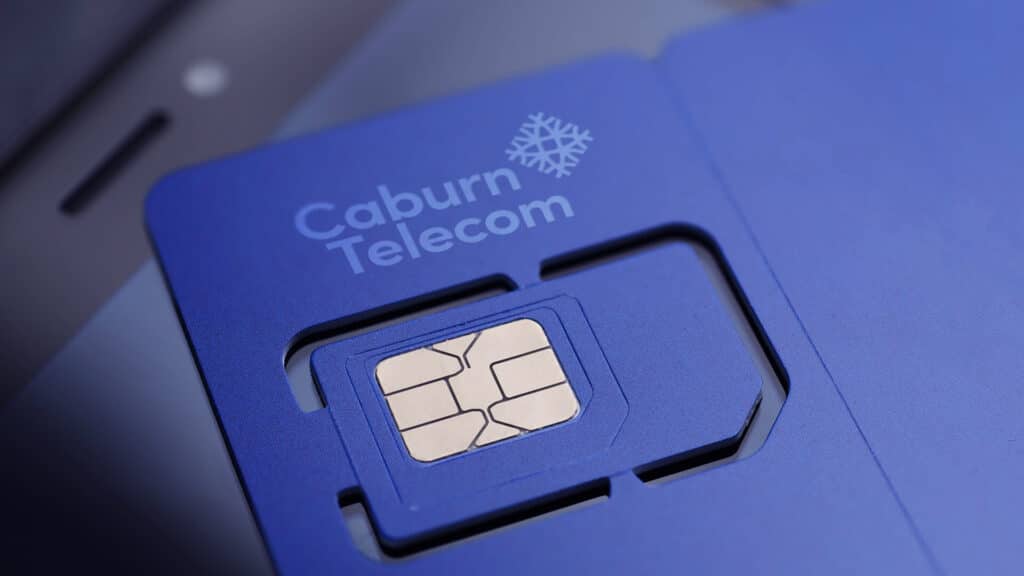What’s in this article?
-
What is an eSIM?
- What is an eUICC SIM or eUICC IoT SIM?
- What is the difference between eUICC and eSIM?
- What is the difference between eSIM and iSIM?
- Do eUICCs make IoT applications easier?
- What are the difficulties of eUICC deployments in IoT settings?
- Is an eSIM better than a plastic SIM?
- eUICC vs eSIM – Choices?
- Typical uses of eUICC
- Discover eSIM and eUICC Solutions with IoT experts Caburn Telecom
What is an eSIM? [an (e)SIM Card Definition]
An eSIM (Embedded Subscriber Identity Module) is a physical SIM card soldered onto the device. It provides access to wireless networks and securely stores personal data without needing to physically replace the SIM card.
An eSIM can be produced in all form factors but is most commonly used in MFF2. They are also sometimes called a Chip SIM or industrial SIM although they can be part of more nuanced SIM card specifications for temperature range and vibration.
Since eSIMs are embedded into each device, they cannot be removed or replaced with another SIM card. One major positive surrounding this is the increased security this offers devices, as the SIM cards are difficult to remove and can be easily concealed in the product design.
eSIMS are typically used in consumer devices, such as smartphones and tablets, but they can be used in other IoT applications as well, such as automated factory robots, wearable devices and smart home appliances.
Learn more:
IoT SIM vs Normal SIM (8 Differences)
A brief SIM history: SIM Cards: The Key to Seamless Global Communication
What is an eUICC SIM or eUICC IoT SIM?
An Embedded Universal Integrated Circuit Card (eUICC) is a type of Subscriber Identity Module (SIM) card used to connect products and devices to mobile networks. It is an embedded form factor of the UICC standard SIM standards.
eUICCs can be used across all SIM form factors including eSIMs to store and update important network access data on mobile devices like smartphones, tablets, or wearables. It is a secure element (SE) that acts as a remotely provisionable SIM card by storing important information such as unique network ID’s and access parameters.
While a regular UICC is a physical SIM card that is only provisional at manufacture, an eUICC is an added software component embedded in the SIM card that can securely store data and be reprovisioned post-manufacture.
While both provide access to networks, an eUICC SIM card can have its network provider profiles changed in the field without having to physically replace a SIM card. This allows IoT device manufacturers or service providers to change their core network provider at some point(s) during the lifecycle of the device.
An eUICC can therefore be programmed remotely and securely to enable over-the-air (OTA) provisioning of profiles, applications and other services.
What is the difference between a UICC and eSIM?
A UICC SIM card is a traditional SIM card set of security SIM card specifications snd configuration which can include an embedded SIM (eSIM) MFF2 format as well as other conventional plastic SIM card formats.
What is the difference between eUICC and eSIM?
An eUICC SIM is a software component of a device that allows remote SIM provisioning of multiple devices. On the other hand, an eSIM is a physical SIM card that is soldered onto the device for added security and can be remotely provisioned to access networks.
An embedded SIM (eSIM) is, therefore, an integrated SIM card which is typically of a small form factor (MFF2) and can be soldered directly onto a printed circuit board (PCB). This differs from a traditional plastic SIM (2FF, 3FF & 4FF) which requires a SIM slot to be attached to the PCB to accept the separate plastic SIM card. eSIMs are also sometimes termed chipsims.
Are all eSIMs eUICC compliant or use eUICC technology?
It is perhaps a common misinterpretation that embedded SIMs are always eUICC compliant.
eUICC, however, are a set of standards controlled by the GSMA which standardise security and remote provisioning of devices across operators in a similar way to their UICC standards at manufacture. This is to enable interoperability across devices and between networks.
Indeed, eUICC-compliant SIM cards can be manufactured in any of the physical formats which includes plastic and embedded SIMs. This includes 2FF, 3FF, 4FF and MFF2 formats.
What is the difference between eSIM and iSIM?
Whereas an embedded SIM is a separate component or circuit card, an iSIM takes the eUICC standards and embeds them on software.
This means that the eUICC standards are implemented directly on the processing computing of the device and not on a separate eSIM or ChipSIM. This can be important for miniature devices that are seeking to save space or cost.
Do eUICCs make IoT applications easier (benefits of eUICC)?
eUICCs are ideally suited for the Internet of Things (IoT), as they offer a secure, convenient way to connect devices to cellular IoT networks and access mobile telecommunications carrier profiles.
This benefits device manufacturers, as they can build products that can easily connect to wireless networks with a standard SIM card for each product.
Additionally, eUICC SIMs are better suited for applications which require multiple different types of SIM cards, as they may enable a truly global footprint from a single SIM manufacturing unit. For example, some IoT use cases include the mass production of globally deployed products.
In turn, using eUICC SIMs makes IoT operations far more affordable to deploy, as fewer individual site visits are needed if malfunctions occur (if any were to happen at all).
Using eUICC SIMs for IoT purposes makes it ‘technically’ easier to switch between core roaming network providers, allowing products and devices to quickly access the best core roaming network depending on their geographic location. This switching of a network is referred to as IMSI reprovisioning.
What are the difficulties of eUICC deployments in IoT settings (cons of eUICC)?
eUICC SIMs for IoT purposes and IoT business(es) allow devices to be somewhat future-proofed by connectivity provider(s). The complexity is that the bootstrap network profile needs to be one that can connect anywhere on start up once it has been shipped and deployed. This is where IoT devices differ from mobile phones. Mobile phones have Wi-Fi access and users who can set them up. If on start up, no network is available, the user can navigate menus on their mobile phone and select an available local network profile.
This is not something that is available to the vast majority of IoT devices. IoT devices typically will have a modem that can only connect to mobile networks. It must therefore connect to a cellular network on start up.
For this reason, a global multi-network profile is therefore recommended for the bootstrap profile to provide the greatest chance of the device initially connecting. Once the device has connected, it can request a local approved profile and be reprovisioned by a GSMA and MNO-approved eUICC management platform.
The eSIM can also be provisioned at manufacture with more than one network profile. This is completed by one of the major SIM card manufacturers who are used by the major network providers and MVNOs and infrastructure providers such as Caburn Telecom and CSL.
eUICC and eSIM Implementation Challenges
A true eUICC SIM card implementation requires commercial agreements between all of the interested parties and usually GSMA compliant and MNO authorised remote provisioning infrastructure. It is important to note that a device with a single modem can only connect to a single carrier network (local MNO and core roaming IMSI profile at any one time. It also is important that eSIMs meet the eSIM standard for manufacturing. Other SIM form factors that are manufactured with eUICC capability must also be manufactured by a MNO approved manufacturing partner. If the implementation is non-standard, then the SIM card application will need to support or absorb minimum order quantities that are applied by the SIM card manufacturer for that particular series of profiles.

IoT SIM cards by Caburn Telecom for global connectivity across multiple industries
Is an eSIM better than a plastic SIM? (pros and cons)
It’s hard to say which is ‘better’ as it really depends on the application. For example, eSIMs are ideal for IoT applications which require low power, are in miniature devices, or suffer vibration in use.
However, plastic SIM cards are better suited for devices which do not require remote provisioning of services and have access to swapping SIM cards. For example, a device that is regularly serviced and maintained or is in a controlled environment may benefit from using a plastic SIM card. If the service provider wishes to change network provider they can simply change the SIM card and the APN of the device.
In some ways, an eSIM or eUICC-enabled card can provide greater degrees of lock-in if the IoT user has little bargaining power to affect changes. Ultimately, reprovisioning devices is dependent upon the commercial agreements between network operators and their eUICC platform integration.
The best choice will always depend on your specific needs and application – but it’s important to understand the differences between eUICC SIMs and eSIMs so you can make an informed decision when choosing a SIM card for your device.
eUICC vs eSIM – IoT Connectivity and Carrier Choices?
For at scale IoT deployments, it is important to get your SIM card specification right at the start of the process. Mobile virtual network operators (MNVOs) or mobile network operators (MNOs) provide both eUICC SIMs and IoT eSIMs as local and global IoT SIM cards, so it is important to understand the differences between them in order to choose the right one for your needs.
As mentioned above, an eUICC SIM is not the same as an eSIM. The main difference between eUICC and eSIM is that eSIM really describes the hardware device, whereas eUICC describes software and hardware compliance with the eUICC GSMA standards.
Both eUICC SIMs and eSIMs are secure elements that store standardised SIM ID data on a device or a physical SIM card, making them reliable options for any type of device.
Chipsim eUICCs are better suited for lower-power specialised, manufactured IoT devices requiring multiple profiles, a single SKU for manufacture and designed in network selection logic.
As stated, the landscape is different for consumer devices such as mobile phones which are backed by major smartphone brands that are able to dictate more the parameters which are implemented by their manufacturers and partner consumer MNOs.
The IoT eUICC standards are more complex as they can not presume access to Wi-Fi on startup, a local/accompanying human user to control the process and once deployed are often irrecoverable.
Ultimately, both eUICC and eSIM are important components in connecting products and devices to mobile networks now and their use will continue to grow as standards and interoperability mature. It is critically important, however, to choose the right option depending on the application, and the right partner(s).
Typical uses of eUICC SIM Cards
Some of the key uses of eUICC SIM cards are:
- Insurance and healthcare: Medical devices and portable scanners that are used in the insurance sector can use eUICC SIMs to ensure secure access to networks across different countries.
- Connected cars: Car manufacturers can embed permanent eUICC SIMs into vehicles for long-term connectivity and physical resilience, allowing drivers to access data on a variety of networks.
- Global access: eUICC SIMs allow businesses to gain access to areas of the world with limited, restricted or no reliable mobile service if they have a high-quality multi-network bootstrap or multiple profiles.
- IoT projects: IoT devices, such as sensors, use eUICC SIMs as it allow them to access networks and transfer data without having to manually insert a SIM card. This can be highly beneficial to manufacturers seeking a single SKU and automated manufacturing processes.
- Single SKU: eUICC SIMs allow businesses to reduce the number of SKUs they need to produce. For example, devices can be shipped globally, and in some problematic regions, reprovisioned on deployment to a local network where roaming isn’t allowed or is prohibitively expensive. This makes it easier for businesses to manage inventory and track shipments.
To learn more about different types of SIM cards, read our post on Global Roaming SIM Cards: Steered vs Non-Steered.
Discover eSIM and eUICC Solutions and the Future of eUICC with Caburn Telecom
Thank you for taking the time to read our detailed post on the comparison between eSIM and eUICC SIM cards. Caburn Telecom is an IoT connectivity provider of eSIM and eUICC solutions for any application. We provide mobile telecommunications for IoT devices and systems. Access premium features available with eUICC and insurance via future autonomy from network operators.
About Caburn Telecom
At Caburn Telecom, we pride ourselves on being a leading internet of things (IoT) connectivity provider globally. Our expertise lies in offering advanced solutions for seamless and efficient connectivity for various IoT devices and applications. With the rise of smart devices and interconnected technology, the choice between eSIM and eUICC SIM cards has become a crucial consideration for businesses and individuals alike. The eSIM, or embedded SIM, is a programmable chip that is soldered directly onto the device’s circuit board and is not physically removable. On the other hand, the eUICC (embedded Universal Integrated Circuit Card) SIM card is an upgrade to the traditional SIM card and eSIM formats, enabling over-the-air updates of mobile network operator profiles. This means that users can switch between different network providers without having to physically change the SIM card.
Other eUICC Details: UICC or eUICC?
At Caburn Telecom, we offer UICC, eSIM and eUICC SIM card solutions and sim profiles, providing our clients with the flexibility and convenience they need. This includes permanent roaming, automatic network fallback, access to eUICC architecture and a variety of SIM card specifications. Whether you require global connectivity, access to new mobile carrier technology, remote SIM provisioning, or secure device management, our comprehensive IoT connectivity solutions and IoT industry expertise ensure we can meet your specific requirements. Partner with Caburn Telecom for reliable and robust connectivity solutions and mobile telecommunications that empower your IoT devices and applications and give you access to carrier connectivity without compromise.



